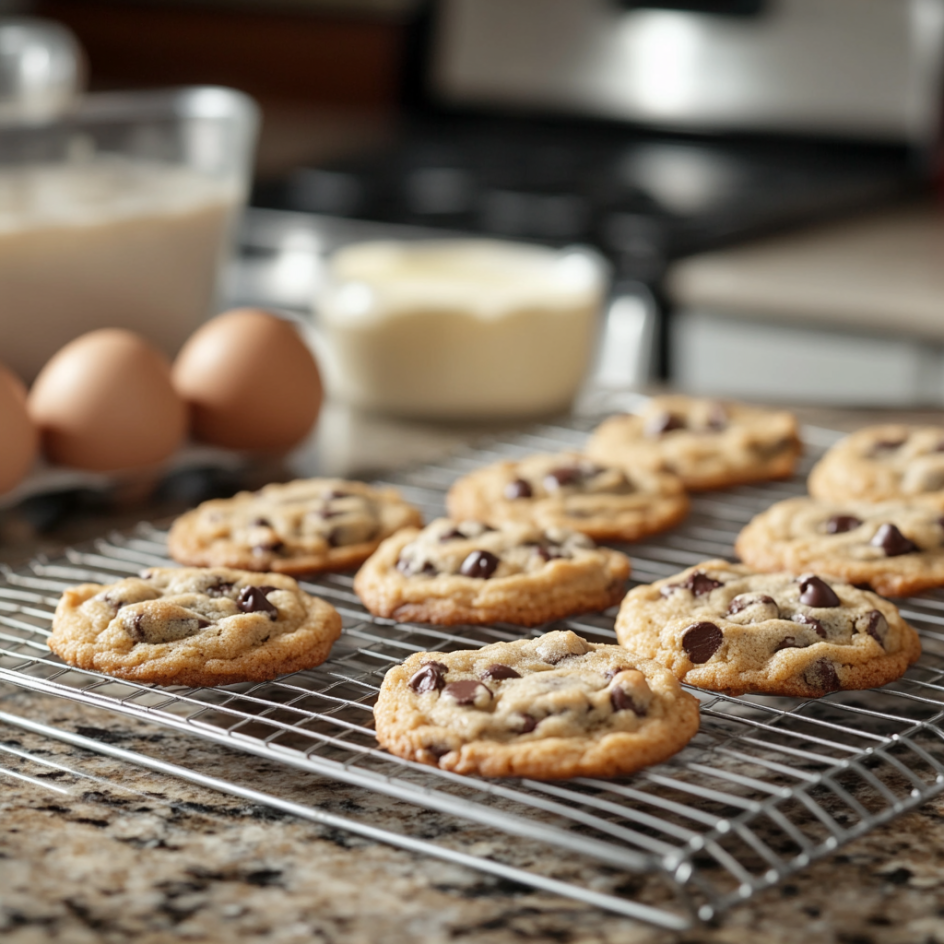Cookies are a beloved treat enjoyed by people of all ages, but preferences can vary widely—some prefer a soft, chewy bite while others enjoy a crispy, crunchy texture. Understanding what makes cookies chewy instead of crispy is essential to getting the perfect cookie every time. Understanding what makes cookies chewy instead of crispy can help you master the art of cookie baking and customize your treats according to your tastes. Knowing the science behind chewy cookies instead of crispy ones will give you control over your cookie’s texture. In this comprehensive guide, we will explore the science and techniques behind making chewy cookies, including ingredient selection, mixing methods, and baking techniques that influence texture. By the end, you’ll have all the knowledge needed to bake the perfect chewy cookies.
Oatmeal Raisin Walnut Cookies Recipe
1. The Science Behind Cookie Texture: Chewy vs. Crispy
Moisture Content and Its Role in Cookie Texture
Moisture is one of the most crucial factors that determine what makes cookies chewy instead of crispy.
- Chewy Cookies: Chewy cookies require a higher moisture content. Ingredients like brown sugar, eggs, and butter contribute to a moist dough that yields a chewy texture.
- Crispy Cookies: Crispy cookies, on the other hand, require less moisture. Using more granulated sugar, baking at a higher temperature, and allowing the cookies to bake longer will result in a crispy texture.
Sugar Type and Its Impact on Cookie Texture
The type of sugar you use has a major influence on the final texture of your cookies.
- Brown Sugar: Brown sugar contains molasses, which retains moisture and helps create a chewy texture. The molasses also gives cookies a deeper, richer flavor.
- White Sugar: White sugar, which lacks molasses, contributes to a crispier texture. It draws moisture out of the dough, resulting in a drier, crunchier cookie.
Fat Content and Its Effect on Cookie Texture
The type and amount of fat used in the recipe also affect the cookie texture.
- Butter: Butter has a low melting point, which helps cookies spread during baking. It creates a softer, chewy texture. Using melted butter can enhance chewiness as the dough absorbs more moisture.
- Shortening: Shortening has a higher melting point, resulting in cookies that maintain their shape better and have a crispier texture. Many bakers use a combination of butter and shortening to get the best of both worlds—flavor and texture.
2. Ingredients That Contribute to Chewiness
Crisco Chocolate Chip Cookie Recipe
The Role of Brown Sugar in Chewy Cookies
- Why It Works: The molasses in brown sugar adds moisture and enhances chewiness in cookies. For chewy cookies, use more brown sugar than white sugar in your recipe.
- Substitutions: If you want even chewier cookies, substitute some of the granulated sugar with additional brown sugar.
How Egg Yolks Contribute to Chewy Cookies
Eggs are an essential ingredient in cookie dough, but the yolks, in particular, are responsible for creating a rich, chewy texture.
- Egg Yolks vs. Whole Eggs: Adding extra egg yolks, or using just the yolks instead of whole eggs, increases the fat content in the dough, which helps keep cookies moist and chewy.
- Extra Egg Yolk: Including an extra egg yolk in the recipe can make a big difference in the chewiness of the cookies. The extra fat from the yolk adds tenderness and richness.
Choosing the Right Flour for Chewy Cookies
- Bread Flour: Bread flour has a higher protein content than all-purpose flour, which leads to more gluten development. This added gluten creates a chewier texture, making bread flour an excellent choice for chewy cookies.
- All-Purpose Flour: All-purpose flour works well for most cookie recipes, but it lacks the additional gluten that bread flour provides. If you want chewier cookies, consider using part or all bread flour in your recipe.
Using Corn Syrup or Honey for Chewier Cookies
Adding a small amount of corn syrup or honey to your cookie dough can help enhance what makes cookies chewy instead of crispy.
- Corn Syrup: Corn syrup is a humectant, which means it helps retain moisture in baked goods. A tablespoon or two of corn syrup can help create a chewier cookie.
- Honey: Honey also acts as a humectant and adds natural sweetness. It contributes to a moist and chewy texture in cookies.
3. Techniques for Baking Chewy Cookies
Mixing Techniques for Chewy Cookies
- Mixing Just Enough: Overmixing cookie dough can result in excess gluten development, making the cookies tough rather than chewy. Mix the dough just until the ingredients are combined to keep the texture tender.
- Creaming Butter and Sugar: Creaming the butter and sugar together incorporates air into the dough, which can make cookies lighter and less chewy. For chewier cookies, beat the butter and sugar just until they are combined, avoiding excessive air incorporation.
Chilling Dough for Chewy Cookies
Chilling the dough is a key step in achieving what makes cookies chewy instead of crispy, visit Refrigeration.
- Firming the Dough: Chilling the dough allows the fats to firm up, which prevents the cookies from spreading too much during baking. Thicker cookies tend to be chewier.
- Flavor Development: Chilling also allows the flavors to meld together, resulting in a richer, more complex taste. For best results, chill the dough for at least an hour or even overnight.
Shaping Dough for Optimal Chewiness
- Thicker Cookies: For chewier cookies, shape the dough into thicker balls rather than flattening them out to understand what makes cookies chewy instead of crispy. Thicker cookies retain more moisture, resulting in a soft, chewy center.
4. Baking Techniques for Perfect Chewy Cookies
Baking Temperature for Chewy Cookies
- Lower Temperature: Baking at a lower temperature, such as 325°F (165°C), allows the cookies to bake more evenly and retain moisture, resulting in a chewy texture.
- Avoid High Temperatures: Higher temperatures can cause the cookies to bake too quickly, resulting in a crispier texture. For chewy cookies, a lower and slower bake is ideal.
Cooking time for soft cookies
- Slightly Underbake: The key to understanding what makes cookies chewy instead of crispy is to slightly underbake them. Remove the cookies from the oven when the centers still look soft and slightly underdone. As the cookies cool, they will continue to cook and set, resulting in a perfectly chewy texture.
- Watch Closely: Keep a close eye on your cookies during the final minutes of baking. Overbaking will result in dry, crispy cookies.
Rotating the Baking Sheet for Even Texture
- Even Baking: To ensure even baking, rotate the baking sheet halfway through the baking time. This helps prevent some cookies from becoming too crispy while others remain underbaked.
5. Add-Ins for Enhanced Chewiness
Adding Oats and Coconut for Chewy Cookies
The addition of ingredients such as oats or shredded coconut can help make the cookies chewy instead of crispy.
- Oats: Rolled oats absorb moisture and add density to the cookies, resulting in a chewy texture. Oatmeal cookies are a great example of how oats can enhance chewiness.
- Shredded Coconut: Coconut adds both moisture and texture, contributing to a chewier bite.
Adding Dried Fruits and Marshmallows for Extra Chewiness
- Dried Fruits: Dried fruits, like raisins or chopped dates, add natural moisture and sweetness, contributing to what makes cookies chewy instead of crispy. Soaking dried fruits before adding them to the dough can make them even plumper and chewier.
- Marshmallows: Adding mini marshmallows to the dough can create pockets of gooey sweetness, adding to the chewy texture of the cookies.
Extra chocolate chips and chunks for a smooth texture
- Chocolate Chips: Chocolate chips add bursts of melted chocolate, which contributes to a rich, chewy texture.
- Chocolate Chunks: Using chocolate chunks instead of chips can create larger pockets of melted chocolate, enhancing the chewiness of each bite.
6. How Oven Types Affect Cookie Texture
How Oven Type Affects Cookie Texture
- Conventional Ovens: Conventional ovens use radiant heat, which may result in cookies baking more slowly, helping achieve what makes cookies chewy instead of crispy. This can be beneficial for achieving a chewy texture.
- Convection Ovens: Convection ovens use a fan to circulate hot air, which can lead to faster baking and potentially crisper cookies. If using a convection oven, reduce the baking time slightly to retain moisture and chewiness.
Rack Placement for Consistent Chewiness
- Middle Rack: Placing the baking sheet on the middle rack allows for even heat distribution, which is crucial for consistent texture. Baking too close to the top or bottom can cause uneven browning, affecting the chewiness of the cookies.
7. Common Mistakes to Avoid for Chewy Cookies
Measuring Flour Accurately for Chewy Cookies
- Measuring Flour Properly: Adding too much flour can absorb excess moisture, resulting in dry, crumbly cookies. Use the spoon-and-level method to measure flour accurately.
Avoiding Overmixing for Chewy Cookies
- Avoid Overmixing: Overmixing the dough can lead to excess gluten formation, making the cookies tough rather than chewy. Mix just until the ingredients are combined.
The Effect of High Temperature on Cookie Texture
- Lower Temperatures Are Key: Baking at high temperatures can cause the cookies to crisp up too quickly, resulting in a less chewy texture. Stick to a lower temperature for a softer, chewier result.
8. Testing Different Recipes for Chewy vs. Crispy Cookies
Comparing Techniques for Chewy and Crispy Cookies
To understand what makes cookies chewy instead of crispy, try baking two batches of cookies—one with ingredients and techniques geared toward chewiness and one for crispiness.
- Chewy Batch: Use brown sugar, extra egg yolks, bread flour, and bake at a lower temperature for a shorter time.
- Crispy Batch: Use white sugar, fewer egg yolks, all-purpose flour, and bake at a higher temperature for a longer time.
Choosing Add-Ins for Chewy or Crispy Cookies
- Chewy Add-Ins: Try adding oats, coconut, or dried fruits to enhance chewiness.
- Crispy Add-Ins: For a crisper texture, avoid ingredients that add extra moisture and stick to basic add-ins like chocolate chips.
9. Storing Cookies to Maintain Chewiness
Proper Storage Techniques for Maintaining Chewy Cookies
- Airtight Containers: Store chewy cookies in an airtight container to retain moisture. Adding a slice of bread to the container can help keep the cookies soft.
- Avoid Refrigeration: Refrigerating cookies can dry them out and make them hard. Keep them at room temperature for optimal texture.
Reheating Cookies to Restore Chewiness
- Microwave for a Few Seconds: If your cookies have become hard, microwaving them for 5-10 seconds can help restore their chewy texture.
- Oven Reheat: Alternatively, warm the cookies in a low oven for a few minutes to soften them without drying them out.
10. How to Fix Cookies That Aren’t Chewy Enough
Adding Moisture to Restore Chewy Cookies
- Bread Trick: Place a slice of fresh bread in the container with your cookies. The cookies will absorb moisture from the bread, making them softer and chewier.
- Microwave with a Damp Paper Towel: Another option is to microwave the cookies with a damp paper towel for about 10 seconds to add moisture back into the cookies.
Rebaking Cookies to Enhance Chewiness
- Rebake for Chewiness: If your cookies are undercooked but not chewy enough, try rebaking them for 1-2 minutes. Keep a close eye on them to ensure they don’t overbake.
Conclusion
Creating the perfect chewy cookie involves understanding the role of moisture, ingredient ratios, mixing methods, and baking techniques. From using more brown sugar and extra egg yolks to baking at a lower temperature and chilling the dough, each step plays an important part in achieving the ideal chewy texture. By experimenting with different ingredients and methods, you can find the perfect balance that suits your preferences. Whether you prefer your cookies chewy or crispy, knowing how to control these factors will allow you to bake cookies that are just right every time. Happy baking!

